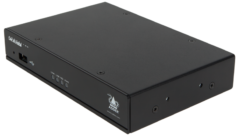Security Watch: Give ‘Em What They Need
Feb 1, 2004 12:00 PM,
By Bret Bass
There is a common misconception concerning the evolution of technology. Many feel that the needs of consumers, whether social or commercial in nature, shape the available technologies. Although those needs influence the direction toward which industries move to develop and advance technologies, a product’s success depends on how well an industry exploits the resources of existing technologies. When new products are introduced, the consumer inevitably holds off on the purchase until the feasibility of the product is proven. There is also the issue of longevity. Will this product continue to be relevant over time?
A BIT OF HISTORY
Technology dictates the direction of security products. The consumer’s need for enhanced security has always existed, and since 9/11, the need continues to grow. John Mallon, a security industry analyst, has been predicting that consumers will be demanding high-end interactive systems that use video, audio, access control, and biometric identification features. However, the products that will succeed in the marketplace are those that already speak to the need. Before interactive video and access control systems, consumers were not crying out for them, but once systems with those features entered the market, the public demanded more access to them.
When manufacturers introduced CCTV systems, they were rudimentary camera and monitor setups used to augment a security guard’s ability to watch a site. They relied on analog cameras, coaxial cables, and a series of video monitors, all home run into a central command room. As the technology advanced, guards could control a motorized camera, reducing the need for an installation requiring a large number of cameras, which cut down on costs.
Manufacturers made great strides with the advent of the digital video recorder (DVR). Until the emergence of these products, video images could be recorded only onto VHS tapes. Kalatel was one of the companies to pioneer a successful DVR. The system still had its limitations, and it was essentially nothing more than a storage device for digitally transmitted data. It was, however, far more effective than a VCR. The DVR had a longer recording time, better quality, easier search features, and more storage space, and it became more cost-effective over time by eliminating the need for videotapes.
The popularity of network technology and the Internet led DVR manufacturers to make their most significant technological advances. Today the majority of DVRs manufactured include a standard 10/100 network, high-speed Ethernet, or a 56K modem connection to allow for remote access to the systems. Other standard features include camera live transmissions, variable fps rate settings for local recording to maximize drive space or image quality in playback, CD burners, alarm I/O ports, pan/tilt/zoom connectors, as many as 32 camera inputs (some support analog and digital), and software for remote viewing, which lets remote users accomplish the same functions as on-site personnel. DVRs also offer one-to-four, bidirectional, voice-over-IP audio channels for simultaneous communication, eliminating the need for intercoms and separate two-way voice board installations.
People at central monitoring stations can perform the same administrative and security features as on-site guards but at a fraction of the cost. Technicians can program the installed systems remotely, even adjusting the cameras. Now that DVRs have opened the market for remote monitoring, integrators are realizing a much bigger return on their profits. Not only are they making good money on a surveillance system installation, but they have now entered the recurring revenue stream, generated from monitoring contracts — a lucrative business model that was previously unavailable to integrators.
BACK TO THE FUTURE
So where is DVR technology going now? Here are just a few of the new areas being explored by DVR manufacturers.
Access control
Most DVRs have I/O relays, which are used for lighting control and for opening electronic doors and gates. SiteView has a DVR that lets operators control video, audio, and access control aspects of a gated community. Instead of employing several costly security guards, communities can use one guard or a contract monitoring station to control gates and verify guests.
Alarm and DVR integration
Companies such as GE-Interlogix and March Networks are developing products that integrate alarm panels with DVR and transmission devices. When alarm systems detect a zone violation, they continue to dial the central monitoring station receiver to report the alarm, but they also begin to transmit live video of the incident. The operators also have access to the local archive of the customer’s DVR to provide them with a preevent analysis of the incident.
Other manufacturers such as Kalatel, Cascadia, Oz Vision, SiteView, and Dedicated Micros are working with the central stations’ automation software companies to allow corresponding video transmission without integrating directly to the alarm systems. When a central station console receives an alarm, the automation software triggers the video application to access the corresponding DVR through the Internet. It is not as seamless as the integrated systems, but it remains highly effective.
The most recent advances eliminate the need of an alarm system altogether. DVRs communicate to remote hosts and users through the use of TCP/IP protocols. DVRs, such as Alpha Systems Lab’s RemoteWatch, can transmit video to a remote PC that serves as a receiver. When an alarm zone, such as an infrared sensor or a door contact, is violated, the DVR transmits the video stream to the remote host by connecting with the remote PC’s static IP address.
Soon the need for alarm systems will be a thing of the past. A central station can already monitor DVRs without alarm panels and receivers. Setting up a bank of operator PCs, each with its own static IP address on the network, transforms each PC into an alarm receiver for digitally transmitted reports from DVR systems.
Behavior recognition
The major DVRs on the market offer or develop some type of motion detection software. This is most commonly found in the DVRs’ playback feature. Kalatel, Eastman, Richardson Electronics, and others have a playback feature that lets you locate an event based on motion in a predefined area. Other DVRs have a feature called intensive recording, which saves hard-drive space by archiving only those events that occur in a targeted area of the camera’s view, based on motion.
Others, such as Teknovation’s PeopleCounter, count people who pass through a desired location. Apart from the obvious security applications in large areas such as airports and malls, the DVR is creating a new need. Consumers are now using this system as a source of inexpensive, in-house marketing research. Store owners can determine whether to keep a new product based on the number of people it attracts to its shelf.
Cernium’s Perceptrak Baseline uses video behavior recognition technology to identify potentially suspicious people, vehicles, and objects. Analyzing and recording as many as 16 cameras on a single PC, the Baseline instantly detects and reports more than six key safety and security events. The system can then generate an alert to monitoring personnel, advising them of a potential situation. An alarm panel reports a problem after the fact; this system warns security personnel of an imminent situation.
EXPLORING THE OPTIONS
Consumers are starting to realize the widespread uses of the burgeoning video technologies. They are using systems not just for security and safety purposes but also for remote employee management, marketing, and even distance education.
Video technology is extending far beyond standard security applications, and it is becoming more available and reasonably priced. For the creative and entrepreneurial systems integrator, this opens up new opportunities and a much larger profit potential.
Show a prospect how the video system satisfies his or her security need and then show that potential customer the other ways in which the system can help with asset management, marketing, and training. Create the need for them, and they will buy.
Bret Bassis a security industry consultant.










